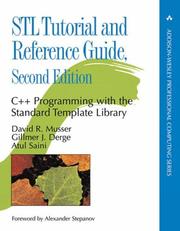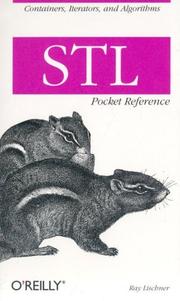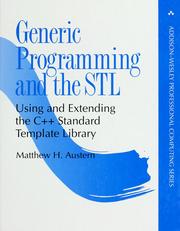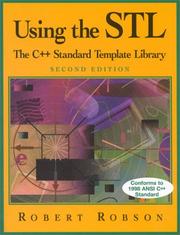| Listing 1 - 10 of 89 | << page >> |
Sort by
|
Book
ISBN: 2729606572 Year: 1997 Publisher: Paris Milan Barcelone Masson
Abstract | Keywords | Export | Availability | Bookmark
 Loading...
Loading...Choose an application
- Reference Manager
- EndNote
- RefWorks (Direct export to RefWorks)
Book
ISBN: 9780321714121 0321714121 Year: 2018 Publisher: Boston : Addison-Wesley,
Abstract | Keywords | Export | Availability | Bookmark
 Loading...
Loading...Choose an application
- Reference Manager
- EndNote
- RefWorks (Direct export to RefWorks)
Templates are among the most powerful features of C++, but they are too often neglected, misunderstood, and misused. C++ Templates: The Complete Guide provides software architects and engineers with a clear understanding of why, when, and how to use templates to build and maintain cleaner, faster, and smarter software more efficiently. C++ Templates begins with an insightful tutorial on basic concepts and language features. The remainder of the book serves as a comprehensive reference, focusing first on language details, then on a wide range of coding techniques, and finally on advanced applications for templates. Examples used throughout the book illustrate abstract concepts and demonstrate best practices. Readers learn: The exact behaviors of templates -- How to avoid the pitfalls associated with templates -- Idioms and techniques, from the basic to the previously undocumented -- How to reuse source code without threatening performance or safety -- How to increase the efficiency of C++ programs -- How to produce more flexible and maintainable software -- This practical guide shows programmers how to exploit the full power of the template features in C++. -- Provided by publisher.

ISBN: 0201379236 9780201379235 Year: 2001 Publisher: Boston, Mass. Addison-Wesley
Abstract | Keywords | Export | Availability | Bookmark
 Loading...
Loading...Choose an application
- Reference Manager
- EndNote
- RefWorks (Direct export to RefWorks)

ISBN: 0201734842 9780201734843 Year: 2003 Publisher: Boston, Mass. Addison-Wesley
Abstract | Keywords | Export | Availability | Bookmark
 Loading...
Loading...Choose an application
- Reference Manager
- EndNote
- RefWorks (Direct export to RefWorks)
Programming --- 681.3*D3 --- Programming languages --- C++ (Computer program language) --- Microsoft Visual C++. --- Standard template library. --- C++ (Computer program language). --- 681.3*D3 Programming languages --- C++ (langage de programmation) --- Microsoft visual c plus-plus (logiciel) --- Microsoft visual c++ --- Standard template library --- C plus-plus (langage de programmation) --- Active Template Library. --- Active template library. --- Microsoft Visual C plus-plus
Book
ISBN: 9780470517062 0470517069 Year: 2009 Publisher: Chichester, U.K. : Wiley,
Abstract | Keywords | Export | Availability | Bookmark
 Loading...
Loading...Choose an application
- Reference Manager
- EndNote
- RefWorks (Direct export to RefWorks)

ISBN: 0596005563 Year: 2004 Publisher: Sebastopol, CA : O'Reilly,
Abstract | Keywords | Export | Availability | Bookmark
 Loading...
Loading...Choose an application
- Reference Manager
- EndNote
- RefWorks (Direct export to RefWorks)
Dissertation
Year: 2022 Publisher: Liège Université de Liège (ULiège)
Abstract | Keywords | Export | Availability | Bookmark
 Loading...
Loading...Choose an application
- Reference Manager
- EndNote
- RefWorks (Direct export to RefWorks)
Multimodal imaging analyses are large scale work, combining experience from many professionals in different disciplines, providing different modalities (i.e. data produced by an experiment) linked together. The growth in multimodal analyses induces a demand for software to make some workflows possible, or help automate some other workflows, at lest partially. Mass Spectrometry Imaging (MSI), although more than 50 years old, continues to see some development in the data processing domain, particularly with machine learning and deep learning applications, where some approaches tackle the preprocessing and the analysis of MSI datasets. The analysis performed on MSI data greatly contributes from multimodal studies, providing a spatial distribution for the molecular content of the sample, thus adding valuable information to the study. Multimodal analyses currently lack an open, collaborative web platform : such tools would allow for a greater share of experience thanks to the collaborative aspect, enable reproducibility because the analyses would run in the cloud, always on the same hardware, and the results would be available to all. Such tools are being developed : Cytomine aims to add more effective multimodal tools to improve its capabilities, but integrating MSI data is not trivial. The analysis of MSI data is not an easy task : file formats for this kind of data are abundant, but often vendor specific. imzML is an open effort to unify all these formats, which is supported by many pieces of software already. However, imzML is not the most appropriate format as its structure is very different from most imaging data format, making it ill-suited for visualization applications such as in Cytomine. This master's thesis introduce a new, versatile and open format based on OME-Zarr, which is suitable for many modalities, including MSI. This file format is benchmarked against imzML to show its potential in server applications, such as Cytomine. In addition to the new file format, the developed pieces of software includes a convertor from imzML and some preprocessing tools designed for the file format. Using the developed file format, a machine learning workflow classifies spectra from a multimodal dataset with label coming from other modalities, and provide a list of important features as a mean of interpretation. While these pieces of software are currently developed to be run on a local machine, they lay the ground for cloud based application that can be integrated with Cytomine.
multimodal --- mass spectrometry imaging --- msi --- cytomine --- template matching --- machine learning --- image registration --- bioimaging --- Ingénierie, informatique & technologie > Sciences informatiques

ISBN: 0201309564 Year: 1999 Publisher: Reading, Mass. Addison-Wesley
Abstract | Keywords | Export | Availability | Bookmark
 Loading...
Loading...Choose an application
- Reference Manager
- EndNote
- RefWorks (Direct export to RefWorks)
Book
ISBN: 9782889192502 Year: 2014 Publisher: Frontiers Media SA
Abstract | Keywords | Export | Availability | Bookmark
 Loading...
Loading...Choose an application
- Reference Manager
- EndNote
- RefWorks (Direct export to RefWorks)
From ABO typing during the first half of the 20th century, to the use of enzymes and protein contained in blood serums and finally direct DNA typing, biology has been serving forensic purposes for many decades. Statistics, in turn, has been constantly underpinning the discussions of the probative value of results of biological analyses, in particular when defendants could not be considered as excluded as potential sources because of different genetic traits. The marriage between genetics and statistics has never been an easy one, though, as is illustrated by fierce arguments that peaked in the so-called "DNA wars" in some American courtrooms in the mid-1990s. This controversy has contributed to a lively production of research and publications on various interpretative topics, such as the collection of relevant data, foundations in population genetics as well as theoretical and practical considerations in probability and statistics. Both DNA profiling as a technique and the associated statistical considerations are now widely accepted as robust, but this does not yet guarantee or imply a neat transition to their application in court. Indeed, statistical principles applied to results of forensic DNA profiling analyses are a necessary, yet not a sufficient preliminary requirement for the contextually meaningful use of DNA in the law. Ultimately, the appropriate use of DNA in the forensic context relies on inference, i.e. reasoning reasonably in the face of uncertainty. This is all the more challenging that such thought processes need to be adopted by stakeholders from various backgrounds and holding diverse interests. Although several topics of the DNA controversy have been settled over time, some others are still debated (such as the question of how to deal with the probability of error), while yet others - purportedly settled topics - saw some recent revivals (e.g., the question of how to deal with database searches). In addition, new challenging topics have emerged over the last decade, such as the analysis and interpretation of traces containing only low quantities of DNA where artefacts of varying nature may affect results. Both technical and interpretative research involving statistics thus represent areas where ongoing research is necessary, and where scholars from the natural sciences and the law should collaborate. The articles in this Research Topic thus aim to investigate, from an interdisciplinary perspective, the current understanding of the strengths and limitations of DNA profiling results in legal applications. This Research Topic accepts contributions in all frontiers article type categories and places an emphasis on topics with a multidisciplinary perspective that explore (while not being limited to) statistical genetics for forensic scientists, case studies and reports, evaluation and interpretation of forensic findings, communication of expert findings to laypersons, quantitative legal reasoning and fact-finding using probability.
Biology - General --- Biology --- Health & Biological Sciences --- probability theory --- interpretation --- Bacterial DNA --- Statistics and the law --- Forensic DNA profiling --- Low-template DNA analysis --- Commercialization --- DNA transfer --- forensic molecular biology

ISBN: 0387988572 9780387988573 Year: 2000 Publisher: New York, N.Y. Springer
Abstract | Keywords | Export | Availability | Bookmark
 Loading...
Loading...Choose an application
- Reference Manager
- EndNote
- RefWorks (Direct export to RefWorks)
C++ (Computer program language) --- 681.3*D3 --- 681.3*D3 Programming languages --- Programming languages --- Standard template library. --- STL (Computer file) --- Programming
| Listing 1 - 10 of 89 | << page >> |
Sort by
|

 Search
Search Feedback
Feedback About UniCat
About UniCat  Help
Help News
News